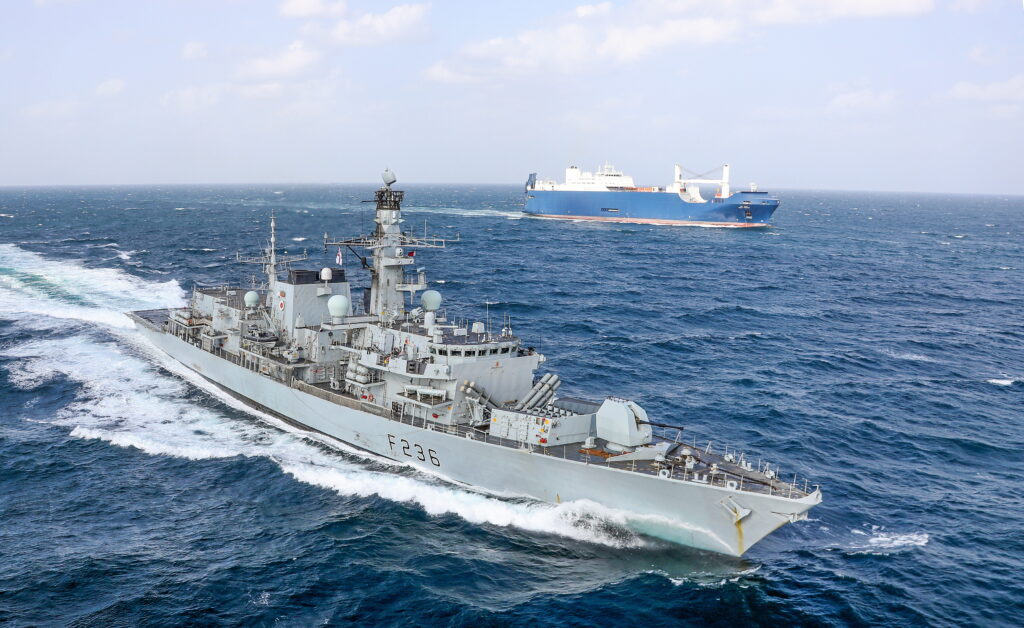
Dr. Lee Willett, London
The UK’s forward-deployed frigate programme in the Gulf is demonstrating operational value for the UK, senior Royal Navy (RN) officers told Seapower as HMS Montrose – the Type 23 frigate that was the first ship deployed under the programme – returned home on 17 December 2022. Type 23 sister ship HMS Lancaster took over on station in late November.
Under the forward-deployed programme, a Type 23 frigate operates across the Gulf and wider region, using the UK’s Naval Support Facility in Manama, Bahrain and other regional facilities (including Duqm Naval Dockyard, Oman) for operational support, maintenance, and rotation of the ship’s two crews (port and starboard). Montrose arrived in the Gulf region in April 2019, having sailed from the UK in November 2018 and conducting a global deployment en route.
The programme’s purpose is to improve availability at sea in a critical region by eliminating rotational ship transits; and to improve effect on station by building understanding of the region and partnerships with regional countries.
As regards availability, Montrose was on operations for 1300 of the 1509 days it was away from the UK, Rear Admiral Steve Moorhouse, the RN’s Director Force Generation, told a media briefing onboard Montrose as the ship sailed back into HM Naval Base Devonport, Plymouth, UK. In current operational terms, that increased availability allowed the UK to maintain increased presence around the critical choke points located in the region, Rear Adm. Moorhouse explained: in future operational terms, it allowed the RN to learn lessons to feed into the planned forward deployment for the incoming Type 31 frigates (which are scheduled to enter service from the mid-2020s).
Keeping Ships in Shipshape Condition
“The key lesson is the model and the concept work,” Rear Adm. Moorhouse told Seapower. “It will change almost everything in how we traditionally go about our business …. Every element changes and modernises, such that we get the best value for money out of the hull.” Such changes, he explained, included ensuring the platform is fully prepared before deploying, for example conducting major refit and upgrade work in the UK, but also conducting maintenance at various partners’ dockyard facilities across the Gulf region. In training terms, there is a need to complete crew and individual training prior to the crew departing from the UK, including through using simulation; in theatre, training can be supported through working with allies and partners or by dispatching training teams from the UK.
As regards in-theatre upkeep, Commander Claire Thompson – commanding officer (CO) of Montrose‘s starboard crew – told Seapower that conducting “operational spring cleans” with a “little and often” approach has been the model used for Montrose. Little and often helps build a maintenance baseline, Cdr Thompson explained. “When you get the opportunity, you can get above that baseline – but don’t drop below it is the key thing.”
As regards improved regional understanding, forward deployment enables the RN to maintain presence for much longer periods. “[The ship’s crews] understand the region far, far better now because they’re persistently there,” said Rear Adm. Moorhouse.
Cdr Thompson added that the handover process with Lancaster‘s CO included detailed discussion of operational routines based around this improved understanding – how to employ the best tactics, how to achieve the mission, and what operational approaches Montrose‘s crews found successful.
- CNO Franchetti: Navy Has a Lot to Offer Young People - April 24, 2024
- NOAA to Break Ground for New facility at Naval Station Newport - April 24, 2024
- US Coast Guard Cutter Dauntless returns home after 61-day Operation Vigilant Sentry patrol - April 24, 2024






